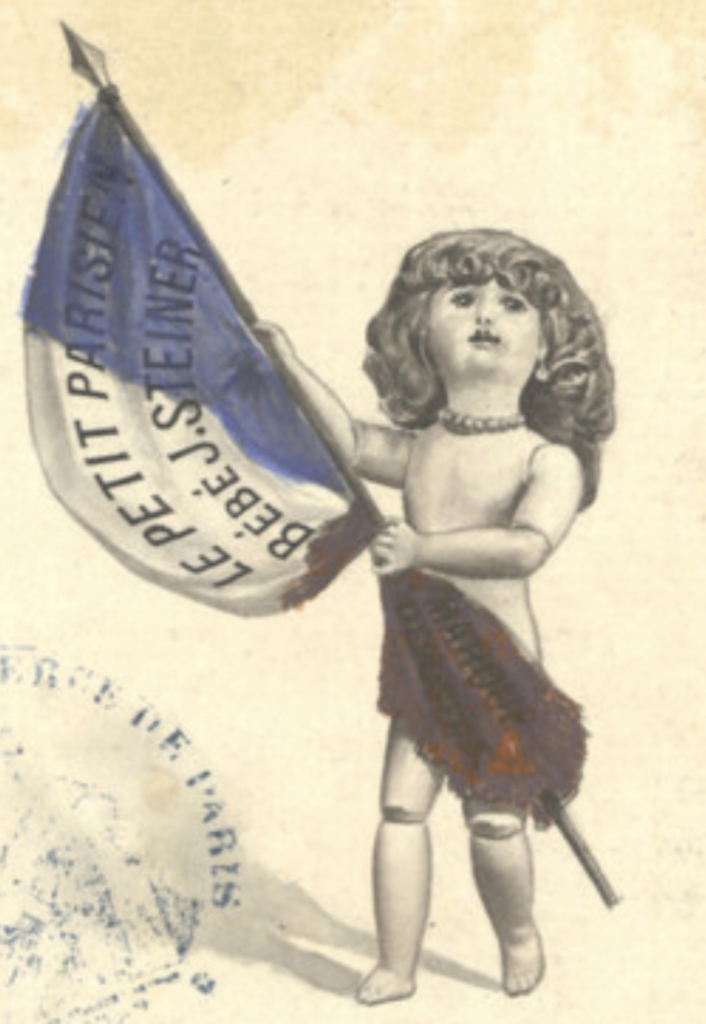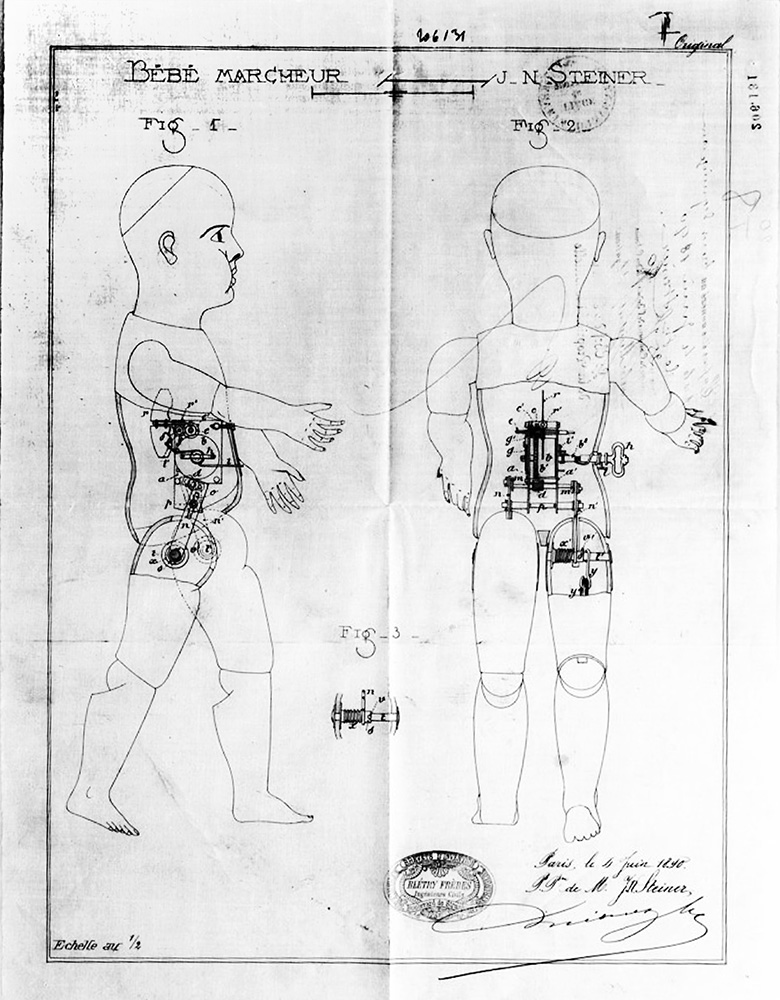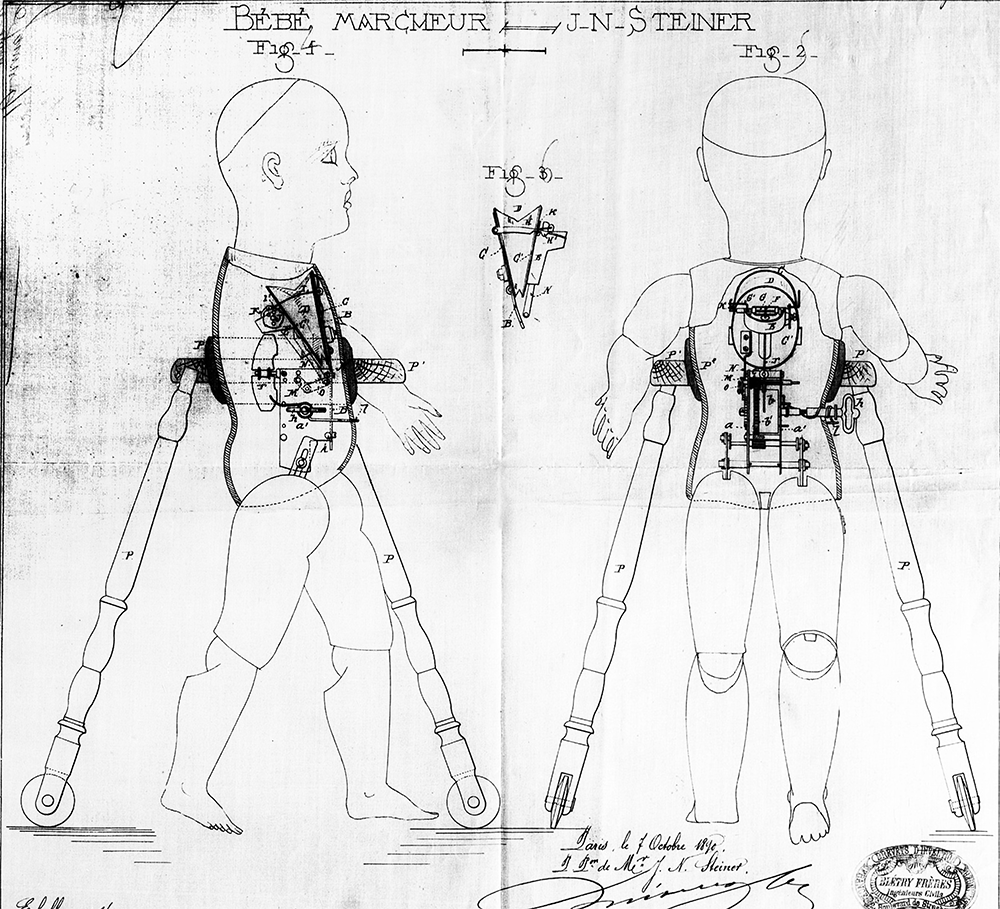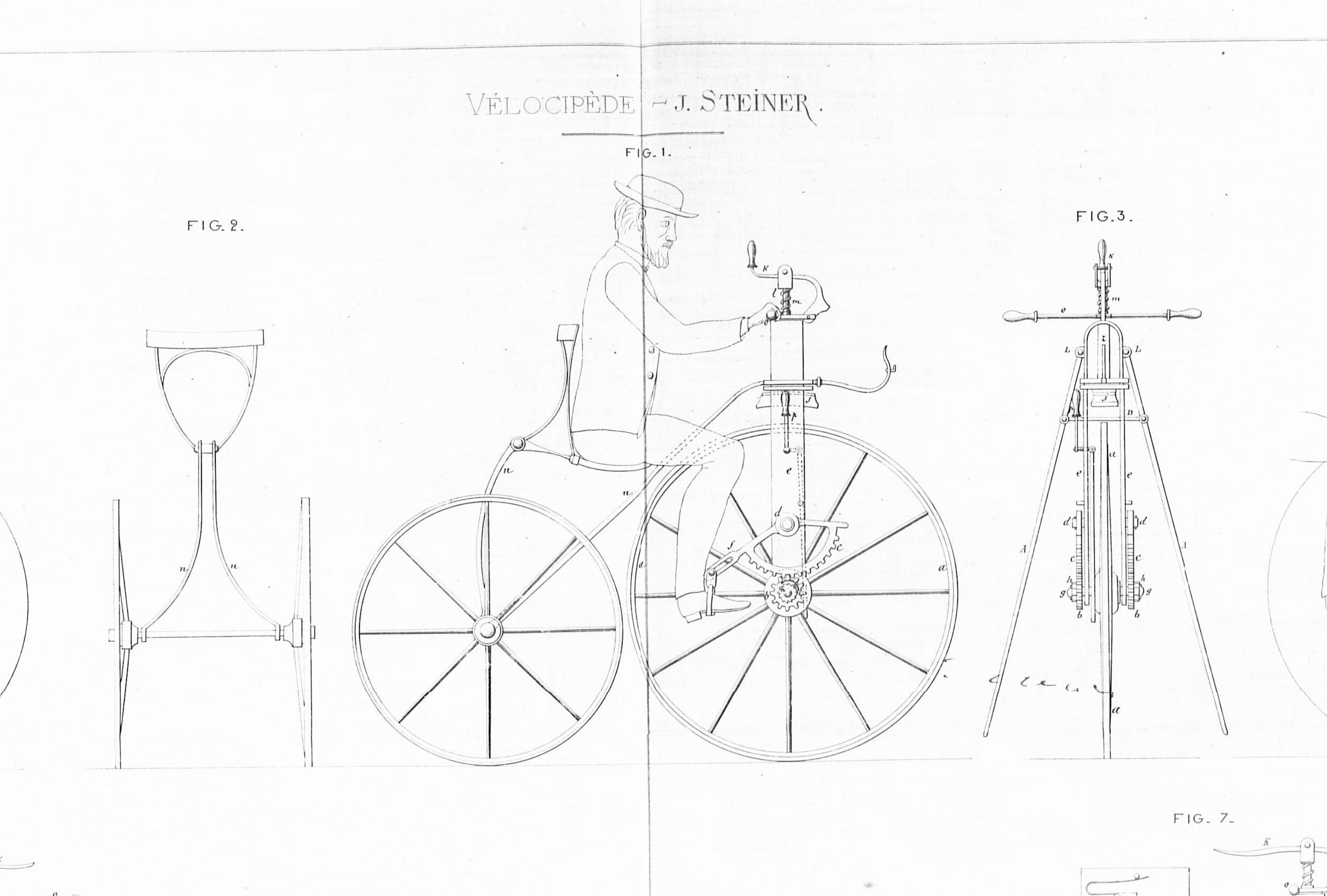The House of Jules Nicolas Steiner, successor to A. Lafosse, was founded in 1855 the same year he registered his first patent #24828 for a mechanical doll. They called him the author of inventions that were landmarks in the history of the doll industry.
Beginning Inspiration
In 1855, while still young, he was struck by the results obtained by Mr. Theroude manufacturer of mechanical toys, in the construction of a large, talking and crying baby. The crying baby doll had mechanisms to complicated and too expensive to function as a common toy. Proof of that lay in the fact that it sold for 1,500 francs (Le Panthéon de l’industrie, Feb. 1889).
Mr. Steiner’s idea desired to make an automaton styled baby that could be put into everyday commerce. He hoped to simplify the mechanism as much as possible, reduce its size so that it could be contained in a smaller common baby doll for the average household. Furthermore, Mr. Steiner wanted this talking baby doll to perform movements and not be immobile like Théroude’s.
Recognizing Steiner Bebes
Early Steiner dolls have what collectors call the Gigoteur face and the Steiner bisque heads then evolved and transformed from this early face.
Steiner Timeline
- 1855 founded
- 1855 first patent
- 1869 Steiner registers the caduceus trademark
- 1878 Silver Medal World Fair
- 1880 Jules Bourgoin buys the business
- 1881 Eye lever patents
- 1889 Bourgoin’s no longer appears
- 1890 Amédée Lafosse buys the business
- 1892 Lafosse registers Le Parisien
- 1893 Lafosse registers Bébé Phenix
- 1899 Lafosse transfers the business to Mettais
- 1899 Mettiais registers Phenix Baby, Bebe Liege, Poupee Merveilleuse, Bébé Modele
- 1902 Steiner passes away
- 1902
- 1904 Daspress owns the business
Jules Steiner Trademarks
J. Steiner Trademark of 1869
In 1869 a Steiner register a trademark that read, “Greffe du Cribunal de Commerce de Paris. NO: 3823
Déposé le 9 Novembro 1869 à 1. heure have Mr. Jules Nicolas Steiner, Constructeur demeurant à Paris, rue de Saintonge no. Dessin de marque devant être estampée en relief sur plaques métalliques appliquées Surles jouets, vélocipèdes et voitures méca niques de mon systeine.” translated “Registry of the Commercial Court of Paris. NO: 3823 Filed on November 9, 1869 at 1:00 with Mr. Jules Nicolas Steiner, Builder residing in Paris, rue de Saintonge no. Design of a brand to be embossed on metal plates applied to toys, bicycles and mechanical cars of my system.”
The oval illustration contains the words across the top, “Marque Depose et Systeme Mecanique.” Then underneath those words in the second row, “BREVETÉ ENTRANCE ET À L’ ENTRANGER.” Across the middle of the trademark are the words, “Marque de Fabrique” and below that his name, “J. Steiner CONSTRUCTEUR.” Then at the bottom “Á PARIS.” Three people signed the document. Steiner simply signed it “J. Steiner” underscored fancifully.
The image in the trademark is a pole with the ball at the top and two wings. Wrapped around the pole are two snakes and below them an oil lamp, a hammer, and a drawing compass.
This Steiner mark is #21 of a set of images at the INPI.FR in the archives for Jouets (toys) during the period from 1857 to 1900. One can view the historic Jules Steiner trademarks at the French site INPI.FR. In French the set is called “Marques de fabrique et de commerce 1857-1920.”
Steiner Trademark of 1889
The green pages of the French trade directory almanac presents “Maison J. Steiner” in 1889. The square contains the words “60 Rue d’Avron, SPTE de Bebes Mques Incassables” or (Unbreakable Baby Shop).

In 1889 Steiner registered his famous trademark with the jointed doll carrying the French flag that reads, “Le Petit Parisien Bebe J. Steiner.” The mark would be found on the torso of many dolls. His signature simply reads, “J. Steiner.”
During the time of this trademark registeration, The French newspaper “Le Petit Parisien” was in circulation. The trademark was modify to show more modesty in the doll when used in the Annuaire-almanach du Commerce by making it appear as if she wore a chemise.
See the Petit Parisien on exhibit at the Barry Art Museum in Virginia here.
(See other French doll trademarks here.)
Jules Steiner Patents and Inventions
- September 17, 1855 Patent 24828 – Mechanical doll
- March 8, 1858 Patent 35726 – Mechanical stop applied to rolling mechanical toys in general
- February 2, 1862 Patent 52929 – Automatic talking baby
- March 13, 1863 Patent 57803 – Mechanically arranged, single-pull doll
- January 25, 1867 Patent 74679 – Animated mechanical toy horse
- May 26, 1868 Patent 81091 – Magic box toy
- November 6, 1869 Patent 85858 – Improvements made in the construction of velocipedes, and in the means specific to their propulsion
- May 29, 18969 Patent 85858 updated
- April 19, 1870 Patent 85858 updated
- June 18, 1880 Patent 137333 – New system for mobilizing eyes in doll or baby heads
- December 13, 1880 Patent 137333 updated
- May 19, 1881 Patent 137333 updated
- June 20, 1881 Patent 137333 updated
- February 2, 1881 Patent 140916 – New way of making artificial eyes for children’s toys, babies, dolls and animals
- May 19, 1881 Patent 140916 updated
- February 26, 1884 Patent 160564 – Balloon Landing System
- May 15, 1884 Patent 162061 – A process of molding, by compressed air, toys made of cardboard or other similar material, such as babies, dolls, statuettes, etc
- June 20, 1889 Patent 199084 – Unbreakable porcelain, biscuit, etc. heads for dolls and babies
- June 4, 1890 Patent 206131 – Baby walker says baby first step (Bébé Marcheur) (in MDZ)
- October 7, 1890 Patent 206131 – updated
- April 27, 1894 Patent 238101 – Automatic shooter
- October 23, 1894 Patent 238101 – updated
Rolling Toys
On March 8, 1858, Steiner filled an application for a 15 year patent for invention for a mechanical order applicable to rolling mechanical toys. The application filed at the secretariat of the prefecture of the Seine department and represented by Mr. Ricordeau of Paris, boulevard de Strasbourg, n. 23.
Through research and perseverance, he succeeded in obtaining the results he desired. He created a small device that moved like a fireplace bellows. The baby doll cried when lying down and stayed silent when standing. In addition, this baby doll could move its arms, legs and head.
Moving Steiner Doll Eyes
Later, he applied his improvements to so-called unbreakable babies. Then, in 1880 and 1881, Steiner made further improvements by making the eyes mobile and iridescent, and the hands mobile as well. It is by means of these improvements that he constructed the “Petit Parisien” that had the special opening and closing the eyes by means of a mechanism special contained in the head. These Steiner doll eyes are easily recognizable by the trademark usually found on them.
In 1889 Steiner’s ad stands solo under the category of “Bebes incassables” in the green pages of Annuaire-Almanach du Commerce, de l’industrie published by Firmin-Didot. His trademarks shows a caduceus (staff of hermes).
Steiner’s 3 Main Inventions
In summary, Steiner gave birth to two main creations: 1) The talking, crying and gesticulating baby doll, whose mechanism consisted of a small clockwork device with bellows placed in the torso of the doll; 2) Le Petit Parisien, produced it was said in seven categories; and 3) the waltzing doll, which was considered a little masterpiece.
The 1891 listing in the French trade directory almanac also called him the creator in 1873 of the unbreakable baby doll without separate ball joints (in contrast to Jumeau bebes incassable that had separate ball joints). The Steiner bebe could speak and had moving eyes and wrists. They made the honest claim that the bisque head was almost unbreakable. Steiner boasted 23 patents. His listing gave the office address of 60, rue d’Avron, and samples at 273, rue St-Denis. Paris.
Bébé Marcheur

Patent 206131 presented a walking Bébé Marcheur with a wind up key on the side of the doll and components inside the torso to make the doll move at the hips in a walking motion. The designs show a doll jointed at shoulders, elbows, hips and knees with fixed wrists and very recognizable Steiner doll hands with fingers spread apart.
The improved or updated patent then presented Bébé Marcheur in a rolling baby walker in 1890.

Jules Steiner Medals and Awards
Steiner won a silver medal in 1878. Then in 1889 he won the gold medal. He won the Diplome d’Honneur in Paris in 1890.
1889 News Correction Regarding the Universal Exhibition
the Le Temps in 1889 made a correction in their newspaper regarding Jumeau and Steiner’s prize awards at the Universal Exhibition that year. “ERRATUM – It was by mistake that we indicated in our Toy Catalogue the Bébé Jumeau as having obtained the Grand Prix at the Universal Exhibition of 1889: the Head of the House being a Member of the Jury, the Bébé Jumeau was Hors concours.
The only Grand Prix was obtained by Lefèvre frères, manufacturers of Toys and the highest Reward in the Baby Article (Gold Medal) by Jules-N. Steiner, inventor of the articulated Baby “Le Petit Parisien”.
The Naked Babies announced in our Catalogue under the name of “Bébé Parisien” as having obtained the Gold Medal at the Universal Exhibition must be mentioned “Le Petit Parisien”, the name under which Mr. Steiner sells this article.”
Address of Jules Nicolas Steiner
1888 Le Jouet Francais
In 1888 his listing in Le Jouet Francais gives lists him as Steiner (Jules-N.), à Paris, rue d’Avron, 60 — Living mechanical babies, unbreakable talking and ordinary babies, called: the little Parisian, moving eyes.
Annuaire-Almanach du Commerce Listings
1870 – “Steiner (J.), fab. spéciale de bébés parlants, mécaniques et articulés,
voitures mécanique nouveau système pour enfants èt grandes personnes, brev. s.g.d.g. en France et à l’étranger, Saintonge, 25.” (special manufacture of talking, mechanical and articulated babies, mechanical cars new system for children and adults, patent s.g.d.g. in France and abroad)
1878 – Steiner (J.), mechanical babies, dolls and articulated toys, r. d’Avron, 60. (formerly rue de Montreuil-Charonne).
1889 – Steiner (J.), fabr. de bébés dits le petit parisien, rue d’Avron, 60. (manufacturer of babies called the little Parisian).
Jules Steiner Advertisements
1891 Ad
The Le Petit Moniteur Universel on 21 octobre 1891 included an ad on page four: “House J. Steiner. A. Lafosse, successor. Le Petit Parisien, unbreakable baby, patented s. g. d. g. Factory: 60, rue d’Avron. Wholesale: 273, rue Saint-Denis. Retail, in all good houses.”
1897 Ad
An ad 1897 lists five categories of bebes incassables (unbreakable dolls): 1) Talking Babies; 2) Babies with moving eyes; 3) Mechanical babies, moving, talking and crying; 4) Baby walking like a child; 5) Double Biscuit Head, almost unbreakable. At that time the address listed was 60, rue Avron 60 with the depot at 273, rue Saint-Denis 273 Paris
1900 Ad
The Official Catalog for the International Universal Exposition of 1900 mentions the former Ancient House of J. Steiner under the name of its successor Jules Mettais. “Mettais (JULES), à Paris, rue d’Avron, 60. Poupées et bébés avec têtes biscuit. Bébés mécaniques (divers modèles). Bébés mulâtres et nègres. PL. I.-C.3 Au Bébé Parisien ». Ancienne maison J. Steiner, fondée en 1855.” (Dolls and babies with biscuit heads. Mechanical babies (various models). Mulatto and Negro babies. PL. I.-C.3 At the Bébé Parisien ». Former J. Steiner house, founded in 1855.)
Steiner Doll Marks
The marks or lack of marks on a Steiner doll helps date that era of the doll. Some marks are incised while others are stamped on the doll. Easiest marks to recognize for any reseller or collector are those that have the name “STEINER” spelled out. Some have STE representing Steiner’s name. Other dolls may have the name BOUGOIN stamped on the head. The dolls may have the recognizable trademarks stamped on the side of the torso as well.
Doll heads with the name of Steiner or Bourgoin may not have any marks or just the word PARIS but are recognizable by their facial features and body construction.
Other marks found on the doll heads include abbreviations such as STE, SIE, SGDG, and others. The SIE stood for a series. Some of the doll faces are known as Series A, B, C, D, E, F, G, and H. The series letter would appear with the size number usually to its right. The series began during the Bourgoin era.
Some dolls have a mark that means FACE or FIGURE. The mark came as abbreviations such as Fre or Fire.
